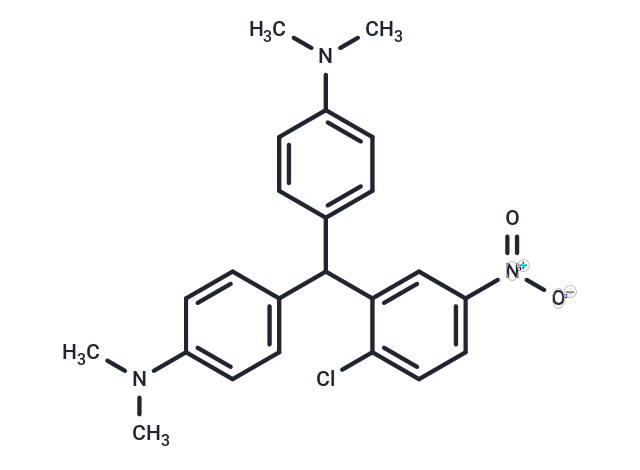Shopping Cart
- Remove All
 Your shopping cart is currently empty
Your shopping cart is currently empty

AL 082D06 (D-06), a selective nonsteroidal glucocorticoid receptor (GR) antagonist (Ki: 210 nM), exhibits outstanding selectivity against AR, ER, MR and PR(Ki > 10 uM).

| Pack Size | Price | Availability | Quantity |
|---|---|---|---|
| 5 mg | $43 | In Stock | |
| 10 mg | $77 | In Stock | |
| 25 mg | $158 | In Stock | |
| 50 mg | $271 | In Stock | |
| 100 mg | $360 | In Stock | |
| 1 mL x 10 mM (in DMSO) | $48 | In Stock |
| Description | AL 082D06 (D-06), a selective nonsteroidal glucocorticoid receptor (GR) antagonist (Ki: 210 nM), exhibits outstanding selectivity against AR, ER, MR and PR(Ki > 10 uM). |
| Targets&IC50 | GR:210 nM(Ki) |
| In vitro | AL 082D06 (D06) demonstrates specific binding to GR with nanomolar affinity, leading to a dose-dependent reduction in transcriptional activation of the MMTV:Luc reporter under submaximal DEX stimulation. This compound effectively antagonizes reporter activity across various glucocorticoid-responsive promoters, including the 3-kb tyrosine amino transferase (TAT) promoter and simpler promoters containing glucocorticoid response element (GRE) sequences. It competes with 3H-Dex for GR binding with similar nanomolar affinity but shows no affinity for other intracellular receptors (AR, ER, PR, and MR) in comparable binding assays (>2500 nM). Additionally, AL 082D06 lacks activation efficacy on progesterone, androgen, mineralocorticoid, retinoid, glucocorticoid, or estrogen receptors, displaying selective antagonism towards GR activity. This specificity contrasts with broader efficacy seen in reference antagonists against other steroid receptors[1]. |
| Kinase Assay | The extract and binding assay buffer consists of 25 mM sodium phosphate, 10 mM potassium fluoride, 10 mM sodium molybdate, 10% glycerol, 1.5 mM EDTA, 2 mM dithiothreitol, 2 mM CHAPS, and 1 mM phenylmethylsulfonyl fluoride (pH 7.4), at room temperature. Intracellular receptors produced in this fashion exhibit reproducible interaction with known ligands at the published affinity. These preparations are subjected to extensive quality control experiments before the assays, covering receptor response, specificity, size, and reference ligand affinity. Receptor assays are performed with a final volume of 250 μL containing from 50-75 μg of extract protein, plus 1-2 nM [3H]Dex at 84 Ci/mmol and varying concentrations of competing ligand (0 to 10 μM). Assays are set up using a 96-well minitube system, and incubations are carried out at 4°C for 18 h. Equilibrium under these conditions of buffer and temperature is achieved by 6-8 h. Nonspecific binding is defined as that binding remaining in the presence of 1000 nM unlabeled Dex. At the end of the incubation period, 200 μL of 6.25% hydroxyapatite are added in wash buffer (binding buffer in the absence of dithiothreitol and phenylmethylsulfonyl fluoride). Specific ligand binding to receptor is determined by a hydroxyapatite-binding assay. Hydroxyapatite absorbs the receptor-ligand complex, allowing for the separation of bound from free radiolabeled ligand. The mixture is vortexed and incubated for 10 min at 4°C and centrifuged, and the supernatant is removed. The hydroxyapatite pellet is washed two times in wash buffer. The amount of receptor-ligand complex is determined by liquid scintillation counting of the hydroxyapatite pellet after the addition of 0.5 mM EcoScint A scintillation cocktail from National Diagnostics[1]. |
| Alias | D-06, AL082D06 |
| Molecular Weight | 409.91 |
| Formula | C23H24ClN3O2 |
| Cas No. | 256925-03-8 |
| Smiles | CN(C)c1ccc(cc1)C(c1ccc(cc1)N(C)C)c1cc(ccc1Cl)[N+]([O-])=O |
| Relative Density. | 1.232 g/cm3 (Predicted) |
| Storage | Powder: -20°C for 3 years | In solvent: -80°C for 1 year | Shipping with blue ice. | ||||||||||||||||||||
| Solubility Information | DMSO: 7.5 mg/mL (18.30 mM), Sonication and heating are recommended. | ||||||||||||||||||||
Solution Preparation Table | |||||||||||||||||||||
DMSO
| |||||||||||||||||||||

Copyright © 2015-2025 TargetMol Chemicals Inc. All Rights Reserved.